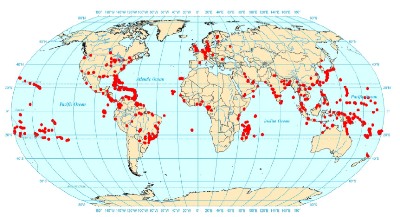Habitat
Oddly enough, researchers have not been able to pinpoint
where this organism originated. One researcher, through a
long process of analyzing fossil records and previous studies,
hypothesized that Tapinoma melanocephalum is from the
Indo-Pacific region because of the similarities between the
ghost ant and other ants from there. Now, as you can see in
the distribution map below, these tiny insects have spread all over the world and have one
of the widest distributions for all ant species. Ghost ants are particularly
abundant in tropical and subtropical regions because they are
fond of the warm climate. They are also found in colder areas
with latitudes greater than 30 degrees but the cold climate
restricts the ant to indoors.
these tiny insects have spread all over the world and have one
of the widest distributions for all ant species. Ghost ants are particularly
abundant in tropical and subtropical regions because they are
fond of the warm climate. They are also found in colder areas
with latitudes greater than 30 degrees but the cold climate
restricts the ant to indoors.
Rather than building nests in soil or sand like the
stereotypical ant, the ghost ant prefers a more temporary home.
In warmer climates T. melanocephalum usually builds
nests outdoors in small and protected areas. Ghost ants utilize areas such as inside dead tree limbs or palm fronds, in
organic debris, clumps of dried grass, and even plant stems.
Since ghost ants are easily disturbed and dislike cold and wet
habitats, nesting in these places allows a greater ability to
leave and reestablish somewhere else without spending extra time
digging nests into the ground. When restricted to indoor places,
the ghost ant is commonly found invading homes, hospitals, and greenhouses
(Harris, 2005; Wetterer, 2009).
How are these ants reproducing enough to spread this widely? Go to
the reproduction page
to find out!